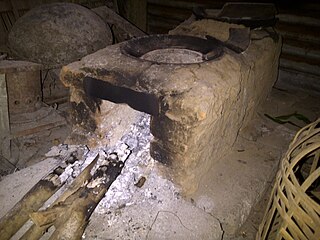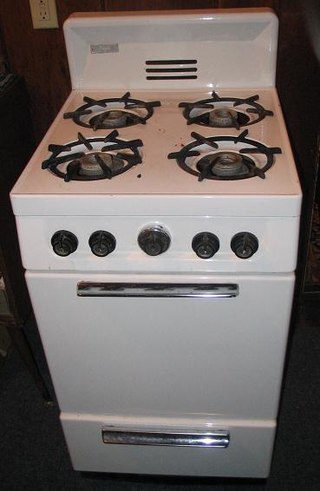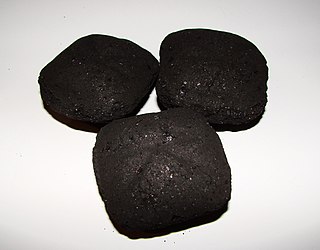
A stove or range is a device that burns fuel or uses electricity to generate heat inside or on top of the apparatus, to be used for general warming or cooking. It has evolved highly over time, with cast-iron and induction versions being developed. Stoves can be powered with many fuels, such as electricity, gasoline, wood, and coal.

Wood fuel is a fuel such as firewood, charcoal, chips, sheets, pellets, and sawdust. The particular form used depends upon factors such as source, quantity, quality and application. In many areas, wood is the most easily available form of fuel, requiring no tools in the case of picking up dead wood, or few tools, although as in any industry, specialized tools, such as skidders and hydraulic wood splitters, have been developed to mechanize production. Sawmill waste and construction industry by-products also include various forms of lumber tailings.

A kitchen stove, often called simply a stove or a cooker, is a kitchen appliance designed for the purpose of cooking food. Kitchen stoves rely on the application of direct heat for the cooking process and may also contain an oven, used for baking. "Cookstoves" are heated by burning wood or charcoal; "gas stoves" are heated by gas; and "electric stoves" by electricity. A stove with a built-in cooktop is also called a range.

A gas stove is a stove that is fuelled by combustible gas such as syngas, natural gas, propane, butane, liquefied petroleum gas or other flammable gas. Before the advent of gas, cooking stoves relied on solid fuels such as coal or wood. The first gas stoves were developed in the 1820s and a gas stove factory was established in England in 1836. This new cooking technology had the advantage of being easily adjustable and could be turned off when not in use. The gas stove, however, did not become a commercial success until the 1880s, by which time supplies of piped gas were available in cities and large towns in Britain. The stoves became widespread on the European Continent and in the United States in the early 20th century.

Coal pollution mitigation, sometimes called clean coal, is a series of systems and technologies that seek to mitigate the health and environmental impact of coal; in particular air pollution from coal-fired power stations, and from coal burnt by heavy industry.

Clean fuel may refer to type of fuel used for transport or a type of fuel used for cooking and lighting. With regards to cooking, the Sustainable Development Goal 7 aims to "Ensure access to affordable, reliable, sustainable and modern energy for all." Clean fuel there is defined by the emission rate targets and specific fuel recommendations included in the normative guidance WHO guidelines for indoor air quality. Clean fuel is one component of sustainable energy.

Smokeless fuel is a type of solid fuel which either does not emit visible smoke or emits minimal amounts during combustion. These types of fuel are popular in areas which ban the use of coal and other fuels such as unseasoned or wet wood which produce smoke.

Household air pollution (HAP) is a significant form of indoor air pollution mostly relating to cooking and heating methods used in developing countries. Since much of the cooking is carried out with biomass fuel, in the form of wood, charcoal, dung, and crop residue, in indoor environments that lack proper ventilation, millions of people, primarily women and children face serious health risks. In total, about three billion people in developing countries are affected by this problem. The World Health Organization (WHO) estimates that cooking-related pollution causes 3.8 million annual deaths. The Global Burden of Disease study estimated the number of deaths in 2017 at 1.6 million. The problem is closely related to Energy poverty and cooking.

Renewable energy in developing countries is an increasingly used alternative to fossil fuel energy, as these countries scale up their energy supplies and address energy poverty. Renewable energy technology was once seen as unaffordable for developing countries. However, since 2015, investment in non-hydro renewable energy has been higher in developing countries than in developed countries, and comprised 54% of global renewable energy investment in 2019. The International Energy Agency forecasts that renewable energy will provide the majority of energy supply growth through 2030 in Africa and Central and South America, and 42% of supply growth in China.

A wood-burning stove is a heating or cooking appliance capable of burning wood fuel, often called solid fuel, and wood-derived biomass fuel, such as sawdust bricks. Generally the appliance consists of a solid metal closed firebox, often lined by fire brick, and one or more air controls. The first wood-burning stove was patented in Strasbourg in 1557. This was two centuries before the Industrial Revolution, so iron was still prohibitively expensive. The first wood-burning stoves were high-end consumer items and only gradually became used widely.

Charcoal is a lightweight black carbon residue produced by strongly heating wood in minimal oxygen to remove all water and volatile constituents. In the traditional version of this pyrolysis process, called charcoal burning, often by forming a charcoal kiln, the heat is supplied by burning part of the starting material itself, with a limited supply of oxygen. The material can also be heated in a closed retort. Modern "charcoal" briquettes used for outdoor cooking may contain many other additives, e.g. coal.

Project Gaia is a U.S. non-governmental, non-profit organization involved in the creation of a commercially viable household market for alcohol-based fuels in Ethiopia and other countries in the developing world. The project considers alcohol fuels to be a solution to fuel shortages, environmental damage, and public health issues caused by traditional cooking in the developing world. Targeting poor and marginalized communities that face health issues from cooking over polluting fires, Gaia currently works in Ethiopia, Nigeria, Brazil, Haiti, and Madagascar, and is in the planning stage of projects in several other countries.
The Clean Cooking Alliance, formerly the Global Alliance for Clean Cookstoves, is a non-profit organization operating with the support of the United Nations Foundation to promote clean cooking technologies in lower and middle-income countries. According to the World Health Organization, 4.3 million people a year die from health problems attributable to household air pollution from the use of polluting open fires and inefficient fuels for cooking. The Alliance was announced in 2010 by then-U.S. Secretary of State Hillary Rodham Clinton. Dymphna previously worked as CEO for the Clinton Climate Initiative organization.

The Kenya Ceramic Jiko is a portable, charcoal-burning stove used for cooking, found primarily in urban homes in Kenya. It was developed through the collaboration of both local and international groups, to reduce fuel consumption.

A clean-burning stove is a stove with reduced toxic and polluting emissions. The term refers to solid-fuel stoves such as wood-burning stoves for either domestic heating, domestic cooking or both. In the context of a cooking stove, especially in lower-income countries, such a stove is distinct from a clean-burning-fuel stove, which typically burns clean fuels such as ethanol, biogas, LPG, or kerosene. Studies into clean-burning cooking stoves in lower-income countries have shown that they reduce the emissions of dangerous particulates and carbon monoxide significantly, use less fuel than regular stoves, and result in fewer burn injuries. However, the emissions some supposedly clean-burning cookstoves produce are still much greater than safe limits, and in several studies in lower income countries they did not appear to be effective at reducing illnesses such as pneumonia induced by breathing polluted air, which may have many sources.

BioLite is a New York City-based startup company that produces off-grid energy products for outdoor recreational use and emerging markets. The company is known for its wood-burning stoves that use thermoelectric technology to create usable electricity from the heat of their fires. It was founded in 2006.
EcoZoom is a certified B Corporation that makes charcoal, wood and biomass cook stoves. The company has offices in Portland, Oregon and Nairobi, Kenya. EcoZoom holds the exclusive license to distribute stove technology designed by Aprovecho in developing countries and a second license to distribute in the United States.

African Clean Energy is a B Corp-certified enterprise which produces and distributes solar-biomass hybrid energy systems in developing countries. The company was founded in Lesotho, where it manufactures the ACE One Energy System. The company's headquarters are in Amsterdam, The Netherlands.

One aspect of energy poverty is lack of access to clean, modern fuels and technologies for cooking. As of 2020, more than 2.6 billion people in developing countries routinely cook with fuels such as wood, animal dung, coal, or kerosene. Burning these types of fuels in open fires or traditional stoves causes harmful household air pollution, resulting in an estimated 3.8 million deaths annually according to the World Health Organization (WHO), and contributes to various health, socio-economic, and environmental problems.
Charlot Magayi is a Kenyan stove designer, climate activist and an Earthshot Prize winner in 2022. She and her company Mukuru Stoves were awarded a million pounds to further develop their idea at a ceremony in Boston, Massachusetts.
















